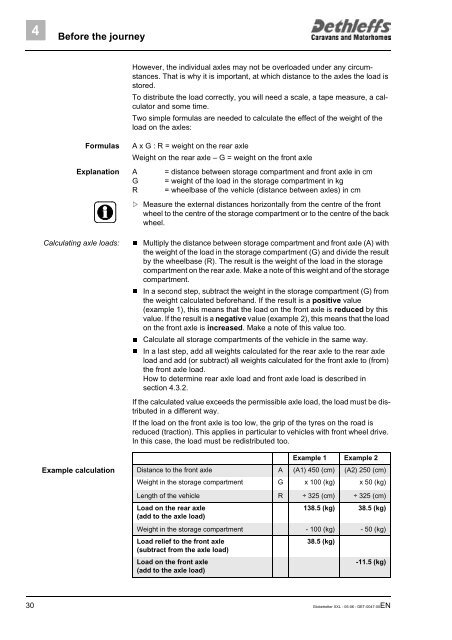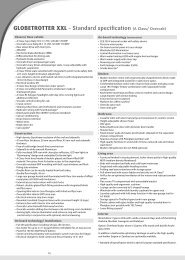User Manual XXL Globetrotter 2006 - Dethleffs
User Manual XXL Globetrotter 2006 - Dethleffs
User Manual XXL Globetrotter 2006 - Dethleffs
You also want an ePaper? Increase the reach of your titles
YUMPU automatically turns print PDFs into web optimized ePapers that Google loves.
4<br />
Before the journey<br />
Formulas<br />
However, the individual axles may not be overloaded under any circumstances.<br />
That is why it is important, at which distance to the axles the load is<br />
stored.<br />
To distribute the load correctly, you will need a scale, a tape measure, a calculator<br />
and some time.<br />
Two simple formulas are needed to calculate the effect of the weight of the<br />
load on the axles:<br />
A x G : R = weight on the rear axle<br />
Weight on the rear axle – G = weight on the front axle<br />
Explanation A = distance between storage compartment and front axle in cm<br />
G = weight of the load in the storage compartment in kg<br />
R = wheelbase of the vehicle (distance between axles) in cm<br />
Measure the external distances horizontally from the centre of the front<br />
wheel to the centre of the storage compartment or to the centre of the back<br />
wheel.<br />
Calculating axle loads:<br />
Multiply the distance between storage compartment and front axle (A) with<br />
<br />
the weight of the load in the storage compartment (G) and divide the result<br />
by the wheelbase (R). The result is the weight of the load in the storage<br />
compartment on the rear axle. Make a note of this weight and of the storage<br />
compartment.<br />
In a second step, subtract the weight in the storage compartment (G) from<br />
<br />
the weight calculated beforehand. If the result is a positive value<br />
(example 1), this means that the load on the front axle is reduced by this<br />
value. If the result is a negative value (example 2), this means that the load<br />
on the front axle is increased. Make a note of this value too.<br />
Calculate all storage compartments of the vehicle in the same way.<br />
<br />
In a last step, add all weights calculated for the rear axle to the rear axle<br />
<br />
load and add (or subtract) all weights calculated for the front axle to (from)<br />
the front axle load.<br />
How to determine rear axle load and front axle load is described in<br />
section 4.3.2.<br />
If the calculated value exceeds the permissible axle load, the load must be distributed<br />
in a different way.<br />
If the load on the front axle is too low, the grip of the tyres on the road is<br />
reduced (traction). This applies in particular to vehicles with front wheel drive.<br />
In this case, the load must be redistributed too.<br />
Example 1 Example 2<br />
Example calculation Distance to the front axle A (A1) 450 (cm) (A2) 250 (cm)<br />
Weight in the storage compartment G x 100 (kg) x 50 (kg)<br />
Length of the vehicle R ÷ 325 (cm) ÷ 325 (cm)<br />
Load on the rear axle<br />
(add to the axle load)<br />
138.5 (kg) 38.5 (kg)<br />
Weight in the storage compartment - 100 (kg) - 50 (kg)<br />
Load relief to the front axle<br />
(subtract from the axle load)<br />
Load on the front axle<br />
(add to the axle load)<br />
38.5 (kg)<br />
-11.5 (kg)<br />
30 <strong>Globetrotter</strong> <strong>XXL</strong> - 05-06 - DET-0047-00EN

















